Women in Engineering Day 2023: Lassonde faculty members share their exceptional journeys
Tags:

When women decide to pursue a career in engineering, they bring resilience, passion, fierce determination and a compassionate awareness of global challenges, helping to diversify the traditionally male-dominated field. Despite the progress that has been made to increase representation and better support women in engineering, there is still a large gender gap in the field.
To celebrate Women in Engineering Day at York University’s Lassonde School of Engineering and inspire future generations of women engineers, we are highlighting the experiences of faculty members from each of our four departments – sharing their inspirations, passions, challenges and achievements.
Learn more about the journeys of these influential women.
Cuiying Jian, Assistant Professor: Department of Mechanical Engineering
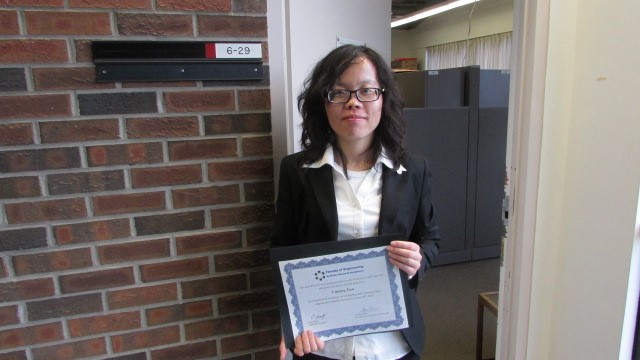
Professor Cuiying Jian during her PhD studies, posing with her Best Presentation Award from the annual Faculty of Engineering Graduate Research Symposium.
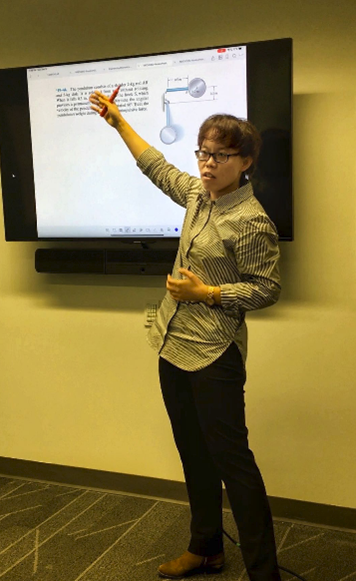
Professor Cuiying Jian giving a lecture in her Dynamics course.
“In high school, I found myself captivated by the fundamental principles that governed the world around us. I would immerse myself in concepts I learned from my physics lectures and replay them in my mind like a movie,” says Professor Cuiying Jian as she reflects on her educational journey. “When it was time to decide on a field of study for university, I discovered engineering, which offered the opportunity to take the concepts I loved in physics and apply them to solutions that could impact people’s lives.” Since joining Lassonde in 2019, her passion for engineering has influenced the School in numerous ways.
The main theme of Professor Jian’s research lab is carbon, specifically natural carbonaceous material (NCM). Her work focuses on developing environmentally friendly processing methods for greener applications of carbon, helping create a more sustainable planet. With her research team, she recently developed a novel method to preserve green energy and generate clean water by utilizing industrial waste materials – addressing two global challenges, including sustainable water production and effective management of industrial waste. Currently, this research is being leveraged with additive manufacturing (3D printing) techniques, to improve energy conservation, water purification and waste revitalization.
Beyond her research, Professor Jian is passionately committed to the mentorship of her students, as well as a collaborative initiative that will integrate equity, diversity and inclusion (EDI) components into the Mechanical Engineering curriculum at Lassonde.
As one of two women professors in the Mechanical Engineering department, Professor Jian continues to be a powerful example for other women who are interested in a career in engineering. “Women bring diverse perspectives to the field; we possess a strong sense of empathy and deep understanding of the needs of different groups of people,” she says. “I think this makes us more aware of the impact of our work, which helps us prioritize safety, usability and sustainability so we can address both function and human needs. By working together, we can become changemakers. The sky is not the limit – one day we’ll reach the stars.”
Hina Tabassum, Assistant Professor: Department of Electrical Engineering & Computer Science
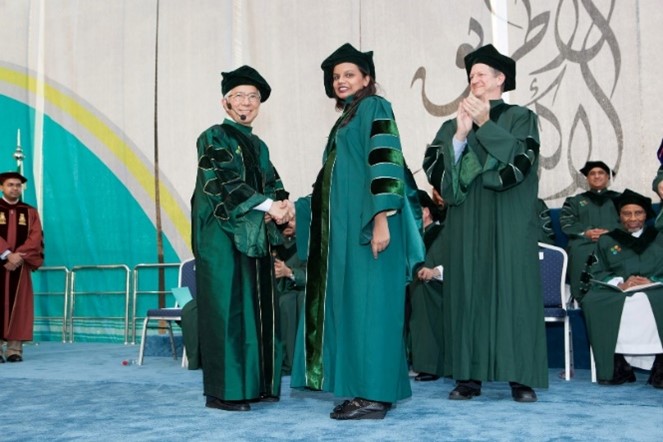
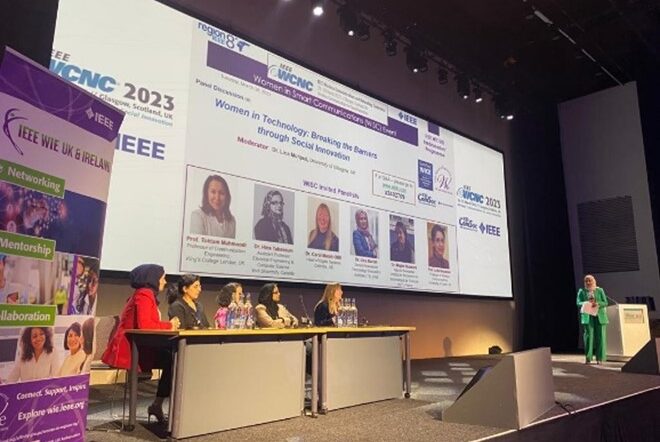
Professor Tabassum started her engineering journey in her home country of Pakistan at NED University of Engineering and Technology where she achieved her bachelor’s and master’s degrees in telecommunications engineering. “I had challenges right from the beginning,” she says. “There was this view that women are just wasting seats and resources; but this didn’t make me quit.” With a flame of determination ignited, Professor Tabassum worked her way to the top of her class each year, changing the views of her peers and establishing herself as the lead in her discipline. She also received gold medals from her university and an industrial manufacturing company, Siemens, for ranking first in her province. “You can’t get discouraged with your first experiences, there will be good and bad everywhere you go,” she says. “Use the negative to polish yourself; to become the very best version of yourself. Get inspired and go for what you want.”
Following her undergraduate degree, Professor Tabassum began working in the industry at Space Upper Atmospheric Research Commission of Pakistan (SUPARCO), while pursuing her master’s degree and starting a family with her husband. She then pursued her PhD in Saudi Arabia and post-doctorate degree in Canada. “My passion really pushed me through,” says Professor Tabassum. “It was hard to attend school, work and support my family simultaneously. But all these things made me happy and so I found a way to balance my work-family life.”
Professor Hina Tabassum’s research focuses on the stochastic modelling and analysis of advanced 5G/6G wireless networks, as well as the development of cutting-edge machine learning solutions for guaranteed quality of experience in 5G/6G networks and high-resolution mobility-aware Wi-Fi sensing. Her impactful work landed her in Stanford University’s List of the World Ranking Top 2% Researchers in 2021 and 2022, and N2Women: Rising Stars in Computer Networking and Communications List as one of the top 10 Rising Stars in 2022. In ongoing work, Professor Tabassum and her research team are looking to incorporate electromagnetic exposure awareness into 5G/6G network planning and resource allocation for joint communication, computing and sensing networks.
Enjoying the benefits of her hard work, Professor Tabassum is now an esteemed and well-respected researcher in her field, as well as a mother to her children who continue to make her proud with their numerous academic achievements.
Mojgan Jadidi, Associate Professor: Department of Earth & Space Science & Engineering

Professor Mojgan Jadidi configuring Augmented Reality Sandbox to be used at Lassonde in the upcoming academic year.
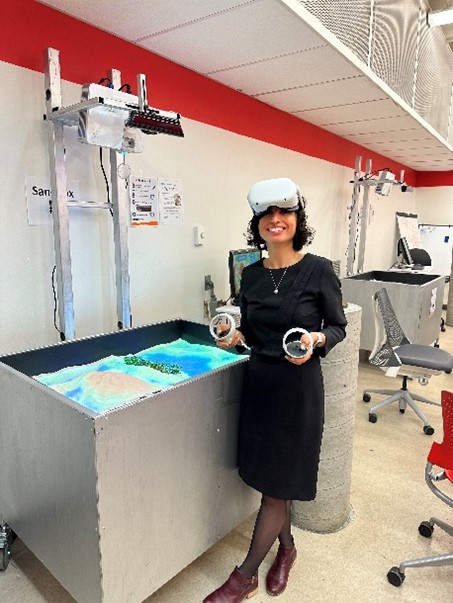
Professor Mojgan Jadidi testing the new package of Virtual Reality Sandbox Activities; a project that she is leading as part of the PAN-Lassonde Academic Innovation Fund on Augmented/Virtual Reality – XR Sandbox Development in Engineering Education.
In her early years, Professor Mojgan Jadidi experienced a terrifying earthquake in her city which destroyed her home and led her to live in a shelter for two months. Unexpectedly, this sparked her curiosity about resilient infrastructure, inspiring her to pursue an education in civil engineering. During her graduate studies, as Professor Jadidi focused on her dream of improving infrastructure design through a better understanding of earthquakes, she noticed a blooming passion for working with data. This pushed her to obtain her PhD in geomatics engineering and study Building Information Modelling (BIM) and Geospatial Information Systems (GIS) during her postdoctoral degree – leading to her current research passion for Geospatial Visual Analytics.
Professor Jadidi’s ongoing journey has been supported by her family who are all active professionals in STEM. “I was spoiled to have my family working in the same field as me, helping me pursue my dream and teaching me about the importance of resilience,” she says. This support prepared her for the challenges she experienced as a woman in engineering. “We have the same education, experience and leadership skills as everyone else, so our capabilities shouldn’t be underestimated.”
Thanks to her passion and perseverance, Professor Jadidi has become a remarkable researcher. Her work has resulted in numerous articles, a first-of-its-kind Topographic Surveying Game that allows civil engineering students to complete surveying coursework online, as well as a recent best paper award from the American Society of Engineering Education for her work regarding art-inspired innovative pedagogy and Augmented/Virtual Reality (XR) in engineering education. Professor Jadidi is now looking forward to her aspirational research regarding the development of digital twin cities, which are replicate models of the physical world. These models use data to simulate and monitor activity in the real world, providing critical information on matters such as building energy consumption, transportation operations and flood risk, to help decision makers better manage and understand metropolitan areas and surrounding environments. “This work can also inform the development of resilient infrastructure, buildings and cities,” says Professor Jadidi. “Maybe making my childhood dreams come true one day.”
Satinder Kaur Brar, Professor: Department of Civil Engineering
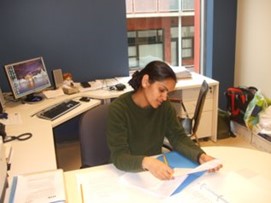
Professor Satinder Kaur Brar accepting her first Assistant Professor position at Institut National de la Recherche Scientifique, Quebec in 2007.
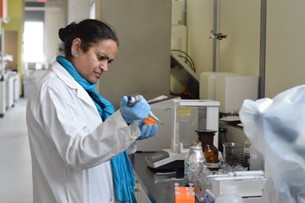
Professor Satinder Kaur Brar working in the lab.
Professor Satinder Kaur Brar is an internationally recognized researcher whose journey in engineering did not actually begin in engineering at all. “As early as middle school, I was fascinated by science and its practicality,” says Professor Brar. “Chemistry was my first love.” After obtaining her bachelor’s and master’s degrees in chemistry disciplines, Professor Brar became highly concerned with the toxic bi-products and solvents involved in processes that would eventually be used in the chemical industry. This realization caused a dramatic shift in her career, leading her to pursue her master’s degree in environmental engineering to gain a better understanding of pollution control at the source. “This interdisciplinary transition in my life made me appreciate how many disciplines can come together to solve the difficult challenges we face in the environment,” says Professor Brar. She later obtained her PhD in biochemical engineering and post-doctorate degree focusing on the use of microorganisms for decontamination of polluted environments.
Throughout her dynamic career, Professor Brar has been an inspiration to many, with her endless drive, unique research and illustrious achievements. She received the Young Woman Scientist Award for her laboratory-to-field research during her professional tenure as a Defense Scientist and was among the first researchers to receive an NSERC Engage Grant for her work with a microbrewery to solve its problem of flocculation. Recognizing her efforts towards environmental sustainability, Professor Brar was also appointed as the first James and Joanne Love Chair in Environmental Engineering, allowing her to leverage her research and positively impact global communities. In ongoing work, she is leading an interdisciplinary, NSERC Alliance-2 project that will explore microplastic detection in sewage sludge. This project involves a large, collaborative effort with researchers from the civil and mechanical engineering departments, three Canadian Universities and industry partners from two countries.
Professor Brar continues to demonstrate engineering excellence and serve as an example of what women can achieve in engineering. “Be persistent and resilient,” she says. “These two qualities can take you anywhere in life.”
Learn more about the many ways in which Lassonde is supporting women and how to get involved. Happy Women in Engineering Day!